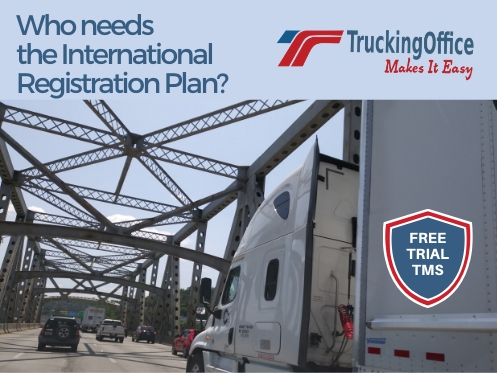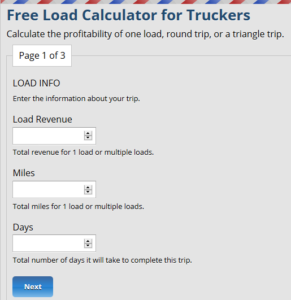The International Registration Plan (IRP) is a registration reciprocity agreement. It regulates the registration and operation of commercial vehicles in the United States and Canada. It was established in the 1960s and early 1970s.
The process of applying for IRP registration can be confusing and time-consuming. This is especially so if you have never completed the application process before. Therefore, many interstate trucking companies rely on trucking company software. This tracks their International Registration Plan reports and payments.
IRP for Trucking
IRP recognizes the registration of commercial vehicles registered by other jurisdictions. Also, it allows for the payment of apportioned licensing fees based on the percentage of miles commercial vehicles travel. Interstate motor carriers can register in their base jurisdiction or their home state. Therefore, they pay a fee based on the portion of distance their vehicles travel within other member jurisdictions. For instance, if an interstate trucking company operates 50% in Ohio, the IRP says that the full annual fee for Ohio must be apportioned at 50%.
States and provinces that are IRP members manage the plans. There is no significant involvement from the federal government. IRP member jurisdictions collect the registration fees from their “home-based” interstate trucking companies. Therefore, they then distribute the fees to each member jurisdiction in which the companies operate.
What is IRP Used for?
The main purpose of the International Registration Plan is to promote interstate commerce. It encourages the fullest possible use of the highway system. It allows registered motor carriers to travel through all IRP member jurisdictions. The main benefit is consolidated licensing and reporting requirements. Everything is through the carrier’s base jurisdiction. In other words, carriers can register with only one jurisdiction – their home state. They only have to pay one jurisdiction. However, they can still legally engage in interstate or interprovincial commerce.
You pay a license fee to each jurisdiction in which the vehicles operate, but only need one license plate and cab card for each vehicle. Carrier vehicles with an IRP registration receive a special apportioned license plate. They also get an apportioned cab card noting which jurisdictions the vehicle may operate in. Additionally, it will note how much weight the vehicle can carry.
Who Needs an IRP Plan
Apportionable vehicles operating in multiple states or provinces must have an IRP. An apportionable vehicle is defined as any vehicle used to transport property or persons for hire in two or more member jurisdictions within the United States or Canada. It also must have two axles and a gross vehicle weight that exceeds 26,000 pounds or three or more axles.
If you have commercial vehicles crossing state lines that are over 26,000 pounds gross vehicle weight or have three or more axles, you must register for an IRP account. Register in your base jurisdiction. There are certain types of vehicles that are exceptions to the definition of an apportionable vehicle. This includes recreational vehicles, government-owned vehicles, city pickup, and delivery vehicles. It also includes vehicles displaying restricted plates and buses used by chartered parties.
Applying for IRP Plates: Practical Trucker’s Guide
Do you plan to operate a qualifying commercial motor vehicle in more than one IRP jurisdiction? If so, here’s what you need to know for obtaining IRP plates:
> Have an established place of business. This must be in the state you’ve claimed as your base jurisdiction. The business must be a physical structure with an address. You’ll need documented proof, such as a utility bill, driver’s license, tax returns, or any government documents showing corporate residency.
> Determine when to apply. IRP application and registration periods differ by jurisdiction. But, the IRP reporting period for all jurisdictions is July 1 to June 30.
> Get or complete the following: USDOT number, FMCSA authorization, Schedule A/E and B for new accounts, Schedule C for existing accounts, or Schedule F for adding jurisdictions.
> When to pay registration fees. These fees vary by jurisdiction. You must contact your base jurisdiction office to find out what their fees and payment options are.
> IRP renewal. IRP requires drivers to renew their plates every year. Check your IRP card for renewal deadlines.
IRP uses mileage to calculate their fees. So, you must keep track of the miles you drove in each jurisdiction. Our TruckingOffice TMS and ELD will make this process much easier.
Understanding IRP registration and who needs it is important. You could face significant penalties if you fail to comply with the requirements of the International Registration Plan. For more information or help, contact Trucking Office today.







We are going to be operating as a “not for hire” and will only be hauling our personal materials we have purchased. It will be across state lines. IFTA said we needed an IRP however reading the above description has me a bit confused.
Can you please help me on this.
If you cross state lines, then you will need both IFTA and IRP.
We have a dump truck we want work in ohio in wv why do i got pay foreign jurisdictions fees
It sounds like you would need IRP plates just for Ohio and West Virginia. You don’t have to pay for states that you don’t drive in.
Do I need IRP for Hotshot setups and Box trucks that are under 26k lb gross weight?
If your truck is rates less than 26,ooo lbs. GVWR then you don’t need to file for an IFTA permit.
Hi Allen,
Is it truck and trailer rating at 26k or less ? or is that just the truck alone ?
Im just looking to have a f250 setup with a 2-3 car trailer traveling just southeast regions
Any info is great thanks
The GVWR rating for the truck includes the truck, trailer, and cargo. It is the rating for how much the truck can haul all together.
Reference to IRP plates: does base jurisdiction and LLC need to be in same state?
I am a newly opened business for hire in California, with box truck 26.000 lbs. Do I need IRP, IFTA? Thank you in advance!
I use my truck and trailer for school purposes in various states. I do not haul any goods or passengers. Do I need IRP plates?
I lease on trucks and in KS we have IRP over 26k and CMV under 26k. Not all states have CMV so it it required that a driver leasing to me from another state running 26k and under to still have a CMV or can they simply run under their own tags while being leased to me?
Do I need an IRP if we are hiring owner operators with their own plates and cab cards, the only thing we provide for them is insurance and book loads?
We are located in southern Ohio and own a single axle dump truck with GVW 33,000 that is for hire for hauling. We occasionally cross into KY & WV because they are within 15 minutes. Do we need IRP & IFTA?
Great overview of the International Registration Plan! It’s incredibly helpful to break down who exactly needs to register and the benefits it provides. As a truck owner, I appreciate the clear explanations and insights on the processes involved. This will definitely assist me in ensuring compliance while saving on costs. Thank you for this informative post!
I own a single axle tractor and gooseneck trailer. I am planning to use it to haul my equipment from my property in Indiana to my new Property in Pennsylvania. I hold a class A CDL and I have driving experience. I will be completely not for hire. Do I need an apportioned registration of can I register as a truck in PA?